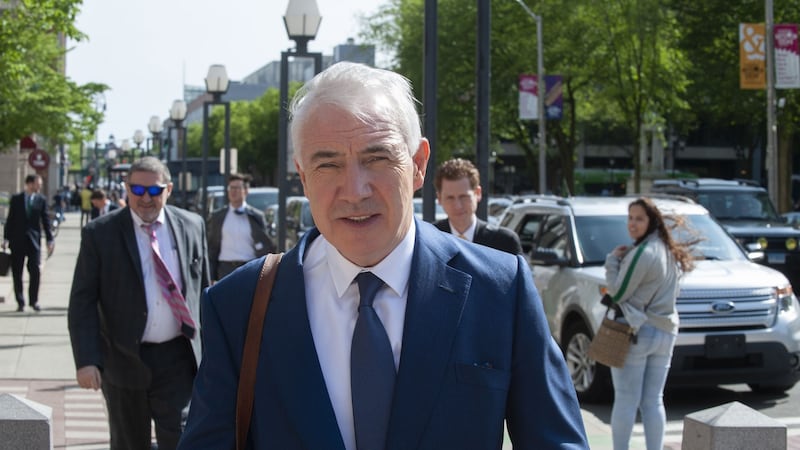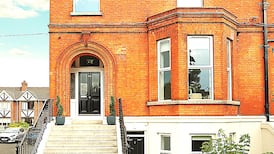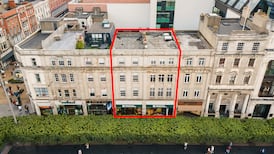Bankrupt developer Sean Dunne said he does not recall transferring money to a joint bank account with his wife Gayle Killilea in 2007 to buy a Swiss condominium (apartment).
During his fourth day of testimony in his civil trial at the US district court in Connecticut, Mr Dunne was questioned extensively about a statement of affairs he submitted to Nama in 2010 covering the years 2005 to 2010.
The court heard that Mr Dunne did not include Walford, the €58 million Ballsbridge home he purchased in 2005, in the statement.

“We took legal advice and the advice was that [Walford] did not fall under the umbrella, the look-back period of five years,” Mr Dunne said.
The trustee in Mr Dunne’s American bankruptcy is suing Mr Dunne and Ms Killilea in a Connecticut court in an attempt to reverse the transfer of tens of million of euro and distribute the assets to creditors.
Cash transfers
The court also heard on Wednesday that Mr Dunne did not include several cash transfers to his wife in the Nama statement of affairs, despite Nama’s request that the developer present “full and complete disclosure” of all assets and transfers.
“We looked at it and we didn’t believe that cash transfers fell under the inquiries they were making,” Mr Dunne said.
Among the payments that were made to Ms Dunne's wife Ms Killilea at this time was €928,364 transferred from an AIB account to a joint Credit Suisse bank account owned by Mr Dunne and Ms Killilea in July 2007. The court heard that this money was used to buy a condominium in Switzerland.
Under questioning by Thomas Curran, lawyer for the plaintiff, Mr Dunne said he did not remember the transaction, though he knew about the property.
“Do I recall it? No,” said Mr Dunne. “I had a company that was turning over hundreds of millions. This transfer maybe wasn’t even signed by me.” Mr Dunne repeatedly said that he and his associates believed that Nama’s requests for information related to real estate (property) and not cash.
Referring to a further €300,000 that was transferred from the joint account to make the final payment for the Swiss apartment, Mr Dunne said that his wife made the payment. “In reality it was her account. I never made one single transfer from that account.”
Mr Curran also referred to further cash payments made to the Credit Suisse account during this time -– a transfer of €1 million in June 2008, €2 million in July 2008, €157,733 in July 2010, and €120,000 in November 2010.
“You didn’t list them,” said Mr Curran.
“We didn’t,” replied Mr Dunne. “We made a call on it. If it was the wrong call, it was the wrong call.”
Mr Curran noted that Mr Dunne had included cash when he listed his unencumbered assets in the statement of affairs to Nama.
“If you knew enough to list cash as an asset on your unencumbered assets schedule, why did you not know enough to list cash for the purposes of transfers?” he asked.
“I find your question a bit confusing,” said Mr Dunne, repeating that he believed that Nama’s disclosure request related to real estate only, “be it right or be it wrong.”
Rental income
The court also heard that Mr Dunne also engaged in other transfers to his wife between 2007 and 2010, including the rental income from a property on Shrewsbury Road in Dublin 4 which was rented to the South African embassy, and the transfer of a site at the K Club in County Kildare to his son, John.
Mr Dunne was also questioned about previous statements he gave under oath concerning the transfer of a total of €100 million to Ms Killilea.
He said that a lot of this money was required for day-to-day living expenses.
He noted in particular that his daughter was attending a special school in Switzerland that cost “about 150,000, 160,000 a year.” He said that Ms Killilea had found the school for his daughter and was happy that they were financing it.
“At that time Gayle was looking after six of us,” Mr Dunne said, referring to his son John and daughter Elaine from his first marriage, as well as the first two of his four children with Ms Killilea.
Mr Dunne was asked when his four children with Ms Killilea were born.
Noting that his two youngest children were born in 2010 and 2013, Mr Curran noted that they were born “after the time that you and your wife were allegedly separated”.
He also said that Mr Dunne began transferring money to Ms Killilea before a judgment for maintenance came down in a Swiss court in August 2010.
Later in the proceedings, judge Jeffrey A Meyer closed the courtroom during discussion of a family court matter.
The court was also shown a letter from Mr Dunne to accounting firm KPMG in late 2008 in response to a letter demanding payment of fees. In the letter, Mr Dunne wrote that there was “no way” his building company Mountbrook could pay a bill for €1.4 million.
“We are now funding our business from our own personal resources,” wrote Mr Dunne, adding that he was no longer paying interest payments to the bank.
“I am not prepared to work needlessly and to the bone and for 16 hours a day for the next couple of years for the other people,” the letter states.
Under questioning by Mr Curran, Mr Dunne said that, at that time, after the collapse of Lehman Brothers, there was a shortage of cash.
Invoices
“We hadn’t received invoices. In essence they were dusting down old files,” he said of KPMG. “We obviously like every other business in Ireland, we had limited access to cash . . . we were trying to balance it and make it go around and make sure we were able to stay in business too.”
He noted that he had paid KPMG and legal advisers Arthur Cox millions in the preceding years, including a payment of €3 million to Arthur Cox one year for professional legal services, and, he believed, €1.5 million to KPMG the same year.
Pointing to a letter from Bank of Ireland to Mr Dunne in 2007 outlining concerns about the liquidity of Mr Dunne’s business, Mr Curran put it to him that he made “a conscious decision” in 2008 to stop paying his banks.
“Absolutely not true,” said Mr Dunne.












